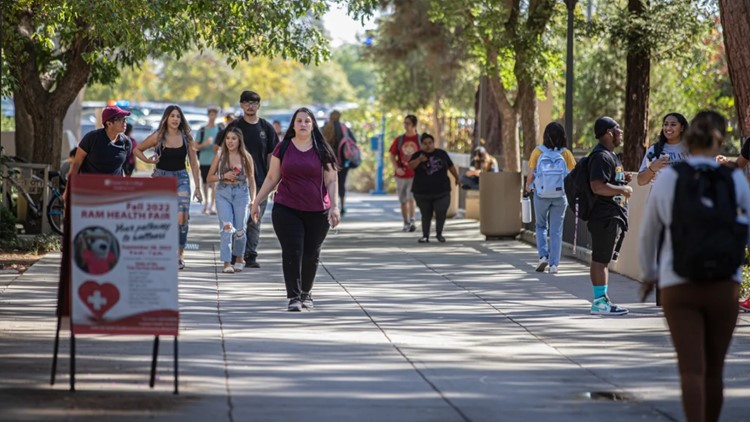CALIFORNIA, USA — This story was originally published in CalMatters
Cerritos College in Los Angeles County was about to cancel plans to build affordable dorms for 396 students at rents of just above $700 a month.
Another community college, Sierra College in Rocklin, was planning to abandon construction of homes for 354 students at rents of $450 a month.
Now two bills are making their way through the Legislature that will allow those projects to continue and reverse a June budget deal that panicked community colleges.
Though Cerritos, Sierra and 17 other California community colleges were promised $1.1 billion in state cash upfront to construct affordable student housing, state lawmakers and Gov. Gavin Newsom yanked that money in June to address California’s then-$31.5 billion budget shortfall.
Instead, those community colleges were told to borrow that money using a financial tool known as a revenue bond, with the state promising to cover the debt payments for 30 years. But without a concrete guarantee that the state would supply the campuses the $78.5 million annually to cover their debt payments, at least two colleges — Cerritos and Sierra — would have backed out of their plans.
The community colleges’ departures from the dorm program would have undermined a novel state effort to house nearly 6,000 community college students in affordable student housing — and thousands more at the state’s public universities — at a time when 20% of community college students experience homelessness.
The two bills would allow community colleges to keep the money they’ve already gotten and return the cash by early summer next year. In place of those funds, the bill package says the state intends to find the money before that summer deadline so that the community colleges won’t have to, resolving the quagmire. Colleges like the fix.
Both Jose Fierro and Willy Duncan, presidents of Cerritos College and Sierra College, respectively, told CalMatters they would not have built the affordable student housing projects without this change. The bills are expected to pass the Legislature early next week and Newsom will likely sign them.
‘Wasn’t what we applied for’
The June budget change “wasn’t what we applied for and it wasn’t the way the program was laid out to us,” Duncan said. He said he wouldn’t have applied for the program to begin with had it required the campuses to raise the revenue.
Duncan’s case had an additional wrinkle: Sierra College was one of several campuses that received a share of roughly $500 million to start building last year. The roadmap fleshed out in the 2022 budget deal said nearly $500 million more would be awarded to other community colleges in 2023. The June change upended those plans.
“I would have had to say to the state, not only can I not continue with the project, but I spent about $7 million so far of the funds that you’ve given me and I have no means to pay that back,” Duncan said.
The dilemma facing colleges looked like this: Imagine a wealthy relative promising to give you cash to buy a house, and then at the last minute your familial Warbucks says, just kidding, “borrow the money and I’ll cover your mortgage payments.”
Sounds fine in theory, unless you struggle to qualify for a loan or that relative decides to not pay one year.
The June decision, while a budget saver for California’s coffers, sowed anxiety for California’s community college leaders and launched a two-month effort to engineer a legislative solution.
“I’ve been working really hard on this,” said Sen. John Laird, a Democrat from Santa Cruz who has fought to preserve the state affordable student housing program since its inception in 2021.
“It’s only in the finance world where you can remove a billion dollars from the budget and say it’s not a cut,” he mused in an interview with CalMatters. Like some of the affected college leaders, the June change surprised him. As recently as May, Newsom was still promising to hand the colleges cash upfront, mostly in line with what was planned in 2022.
The fix in the two bills “was hard to tie down over two months,” Laird said, who worked with community college presidents, the community college system’s chancellor’s office, legislative leaders and Newsom’s administration to reach a solution.
Not all affected campuses would have walked from their housing projects. While Lake Tahoe Community College’s board had concerns with moving from upfront cash to issuing bonds, “they trusted the state and were still willing to move forward because they knew it’s the right thing to do for our students,” said Laura Metune, the college’s senior director of government relations. “But having the state take on the debt is a much better option for the college.”
Keith Curry, president of Compton College, wouldn’t have abandoned his college’s project for 250 dorm beds either. “My track record as a college president is that we figure stuff out that’s important to our students,” he told CalMatters.
How the two bills would work
The legislative fix would reverse the June budget deal, which told the colleges that received grants from the 2022 budget act to pay back that money now, explained Laird’s staff. Instead, the two bills are telling those colleges to return the cash to the state by June 29, 2024, or a short time after. Doing so allows those colleges to move ahead with their construction plans and avoid delays, Laird told CalMatters, which can be expensive in construction.
The two bills also promise that the state will issue a bond on its own or pursue some other financing option to supply the community colleges the money they’ll need to continue their construction projects.
When the state plans to find the new revenue is an unsettled question. The bill language sets a deadline of late June or July of next year. But Laird is urging the governor’s administration to settle the matter as soon as January.
“It would just be good that there'll be some certainty and everybody relax,” Laird said at a Senate budget committee hearing last week.
Three of the community colleges picked to build affordable housing this year were initially going to split the costs with the University of California. With this budget fix the UC will pick up the tab through its debt-financing program and the state will cover the system’s annual debt payments.
Both the UC and California State University systems were also promised cash upfront to build student housing and then told to issue bonds instead. However, they have a long history of operating student dorms and generating income from them, so they could manage the new bond arrangement.
Why this was a financial risk
For colleges, the problems were manifold. The state budget approves a spending plan on a year-to-year basis. That means a program funded one year can be cut the next if there’s an economic downturn. The colleges feared that the annual debt payments the state was promising to pay for campus bonds could disappear for several or more years, Chris Ferguson, a manager with the California Department of Finance, wrote in an email to CalMatters.
Without a 30-year guarantee of state money flowing to colleges and a drop in state support, the campuses would have to dip into their operating budgets to pay for the debt that was basically foisted upon them, which in turn could lead to cutting classes and other student programs, Duncan said.
“And then I probably wouldn't be able to keep the housing affordable anymore, either,” he added. “I would have had to increase the rents.”
Some community colleges worried that financial firms that purchase bonds would view the schools as risky bets. Without anyone buying a bond, a college wouldn't have been able to access the money needed to build a new dorm.
Because the rents had to be low, the community colleges couldn’t count on extra revenue to finance their bonds. And without a state guarantee of the money arriving annually, there would be no financial cushion that the colleges could point to as a way to assuage the worries of potential bond buyers. Nor do California’s community colleges, with few exceptions, manage student housing, so they couldn’t rely on incoming revenue from existing dorms.
With the bond route, “we would have to change the scope of the project to be able to produce revenue,” Fierro said. The student rents wouldn’t be affordable anymore, he said.
More affordable housing coming for students
Sierra College’s dorm project will consist of three-bedroom apartments, with each bedroom housing two students. The apartments will include two bathrooms, a living room and kitchen, Duncan said.
The dorm building will also feature computer labs and contain study space where campus tutors can help students. The homes, which the college hopes will be ready for move-in by fall 2025, will be adjacent to the campus food services area and library. Duncan said the campus has raised more than $1 million, including from local businesses, to waive the rents for a few students experiencing homelessness.
Cerritos College’s four-story dorm will sit on-campus and include 32 single-occupancy studios plus a mix of two- and four-bedroom apartments, each with two bathrooms. The two-bedroom apartments will house two students per bedroom, according to campus plans.
Without the legislative fix, these homes wouldn’t exist.
“You have to reflect the sense of urgency that existed here back into the decision-makers, and that was my job so that people would not walk away,” Laird said.



